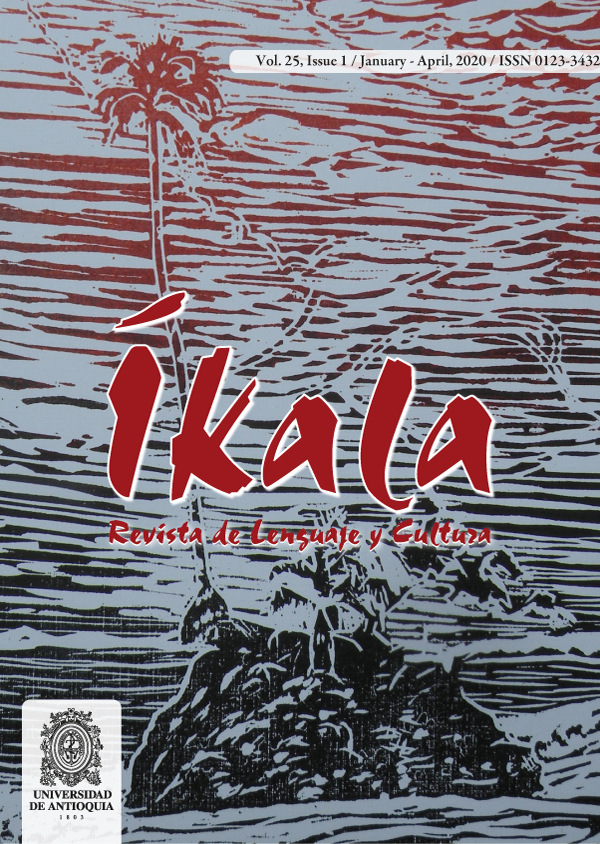Text-Illustration Transmutation: A Model for the Analysis of its Effect on the Dynamics and Functions of Children’s Books
DOI:
https://doi.org/10.17533/udea.ikala.v25n01a08Schlagworte:
picture books, text-picture dynamics, children's literature, translation theory.Abstract
The present paper aims to apply theoretical aspects of translation studies to the analysis of picture books. For this purpose, it introduces a three-stage analytical model aimed at the study of text-picture transmutations in the aforementioned genre. In the first stage, the information that the visual element (picture) conveys, adds, omits or modifies compared to the verbal element (text) is identified using different translation strategies and procedures. In a second stage, these results are used for the study of text-picture dynamics, which determine the message that both elements' convergence will eventually transmit. In the third one, the information that stems from the previous stages is used to identify some of the main functions of children´s literature and to establish to which extent they are foregrounded or overshadowed by the interrelationship between texts and pictures. As a means to exemplify the application of this analytical model, the paper studies various pas sages and their corresponding illustrations from Marla Frazee's A Couple of Boys Have the Best Week Ever.
Downloads
Literaturhinweise
- Anderson, N. A. (2002). Elementary children's literature: The basics for teachers and parents. Boston: Allyn and Bacon.
-Barone, D.M. (2011). Children´s literature in the classroom: Engaging lifelong readers. Nueva York; Londres: The Guilford Press.
- Campos, H. (1992). Metalinguagem & Outras Metas. São Paulo: Perspectiva.
- Eco, U. (2008) Decir casi lo mismo. Barcelona: Lumen.
- Frazee, M. (2008). A Couple of Boys Have the Best Week Ever. Orlando: Harcourt, Inc.
- Hunt, P. (2001). Children’s literature. Oxford; Maden: Blackwell Publishers.
- Hurtado Albir, A. (2001). Traducción y traductología, introducción a la traductología. Madrid: Cátedra.
- Jakobson, R. (1959/2000): On Linguistic Aspects of Translation. In L. Venuti, (ed.) The Translation Studies Reader, (pp. 113-118). Londres; Nueva York: Routledge.
- Nikolajeva, M. y Scott, C. (2001). How Picturebooks Work. Nueva York; Londres: Garland Publishing.
- Pereira, N. M. (2007). Book Illustration as Intersemiotic Translation: The Case of Alice in Wonderland in Brazil. In D. Kenny and K. Ryou (eds.), Across Boundaries: International Perspectives on Translation Studies, (pp. 56-77). Newcastle: Cambridge Scholars Publishing.
- Pereira, N. M. (2008). Book Illustration as (Intersemiotic) Translation: Pictures translating words. Meta, 53(1), 104-119. doi:10.7202/017977ar
- Salehipour, M. y Tabatabaei Lotfi, N. (2016). From Poem to Painting: An Aspect of Intersemiotic Translation, a Case Study of Rustum and Sohrab Story. Theory and Practice in Language Studies, 6 (10), 2007. doi:10.17507/tpls.0610.17
- Salmani, B. y Eghtesadi, Z. (2015). An Intersemiotic Approach Towards Translation of Cover Designs in Retranslated Classic Novels. Theory and Practice in Language Studies, 5(6), 1185. doi:10.17507/tpls.0506.09
- Schwarcz, J. H. (1982). Ways of the Illustrator: Visual Communication in Children’s Literature. Chicago: American Library Association.
- Serafini, F., & Moses, L. (2014). The roles of children's literature in the primary grades. The Reading Teacher, 67(6), 465-468
- Sipe, L. R. (1998). How picture books work: A semiotically framed theory of
text-picture relationships Children’s Literature in Education, 29(2),
–108.
- Sitzia, E. (2010). ‘Where is the Prince?’ Unlocking Doré’s Illustration of Perrault’s Cinderella. Relief: Revue Électronique De Littérature Francaise, 4(2), 158-173. doi:10.18352/relief.543
- Vinay, J. P., and Darbelnet, J. (1995). Comparative Stylistics of French and English: A Methodology for Translation. Amsterdam; Filadelfia: John Benjamins.
Veröffentlicht
Zitationsvorschlag
Lizenz
Copyright (c) 2020 Íkala, Revista de Lenguaje y Cultura

Dieses Werk steht unter der Lizenz Creative Commons Namensnennung - Nicht-kommerziell - Weitergabe unter gleichen Bedingungen 4.0 International.












